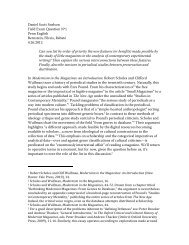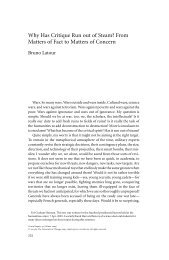The Exploit: A Theory of Networks - asounder
The Exploit: A Theory of Networks - asounder
The Exploit: A Theory of Networks - asounder
Create successful ePaper yourself
Turn your PDF publications into a flip-book with our unique Google optimized e-Paper software.
60 Nodes<br />
individuation <strong>of</strong> networks as a whole and the individuation <strong>of</strong> the<br />
component parts <strong>of</strong> networks.<br />
Individuation in the control society is less about the production <strong>of</strong> the<br />
one from the many, and more about the production <strong>of</strong> the many through<br />
the one. In the classical model, it is the hive that individuates the drone.<br />
Here, however, every drone always already facilitates the existence <strong>of</strong> multiple<br />
coexisting hives. It is a question not <strong>of</strong> being individuated as a “subject”<br />
but instead <strong>of</strong> being individuated as a node integrated into one or more networks.<br />
Thus one speaks not <strong>of</strong> a subject interpellated by this or that social<br />
force. One speaks instead <strong>of</strong> “friends <strong>of</strong> friends,” <strong>of</strong> the financial and health<br />
networks created by the subject simply in its being alive.<br />
<strong>The</strong> distinction from political philosophy between the individual<br />
and the group is transformed into a protocological regulation between<br />
the network as a unity and the network as a heterogeneity<br />
(what computer programmers call a “struct,” a grouping <strong>of</strong> dissimilar<br />
data types). It is the management <strong>of</strong> this unity– heterogeneity flow<br />
that is most important. In terms <strong>of</strong> protocological control, the question<br />
<strong>of</strong> individuation is a question <strong>of</strong> how discrete nodes (agencies)<br />
and their edges (actions) are identified and managed as such. Iden ti -<br />
fi cation technologies such as biometrics, tagging, and pr<strong>of</strong>iling are<br />
important in this regard, for they determine what counts as a node or<br />
an edge in a given network. Some key questions emerge: What resists<br />
processes <strong>of</strong> individuation? What supports or diversifies them? Does<br />
it change depending on the granularity <strong>of</strong> the analysis?<br />
2. <strong>Networks</strong> are a multiplicity. <strong>The</strong>y are robust and flexible.<br />
While networks can be individuated and identified quite easily,<br />
networks are also always “more than one.” <strong>Networks</strong> are multiplicities,<br />
not because they are constructed <strong>of</strong> numerous parts but because<br />
they are organized around the principle <strong>of</strong> perpetual inclusion. It is a<br />
question <strong>of</strong> a formal arrangement, not a finite count. This not only<br />
means that networks can and must grow (adding nodes or edges) but,<br />
more important, means that networks are reconfigurable in new ways









